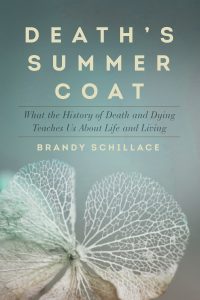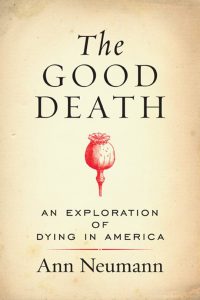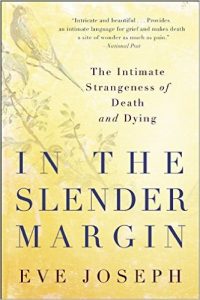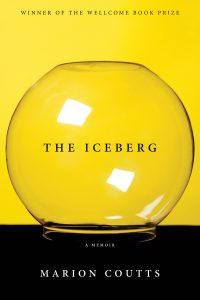
Death goes in and out of fashion. The topic lingers behind euphemisms for a few years, and then someone calls it forth again: Elisabeth Kübler-Ross with her disciplined On Death and Dying in 1969; Susan Sontag with her angry but profound Illness as Metaphor in 1978 and the empathetic follow-up AIDS and Its Metaphors, in 1988; Derek Humphry, implausibly, with his suicide handbook Final Exit in 1991; Sherwin Nuland with his magisterial How We Die in 1993; more recently, Joan Didion with her agonizingly precise The Year of Magical Thinking in 2005; and Atul Gawande with his humane Being Mortal in 2014. Each of these books argues, one way or another, for a continuum between life and its conclusion. The gloss of youthful vitality can persuade us that life is for the living, but life is also for the dying, and repudiating that ultimate punctuation escalates our anxiety and deprives us of final dignity. Time and again, we must clarify our individual and collective beliefs about how the last chapter changes the rest of the narrative. “Or not to be” is not in fact a question.
These recent weeks have seen the publication of five books about death: one by a historian; two by hospice workers; one by a widow; one by a man who is dying himself. Several of them quote Dylan Thomas’s “Do Not Go Gentle Into That Good Night” to advocate resilience, then map the fine line between denial and succumbing. In Death’s Summer Coat, Brandy Schillace complains, “The modern Westerner has lost loss; death as a community event, and mourning as a communal practice, has been steadily killed off.” Examining rituals of bereavement across cultures and across time, she suggests that everyone else has been better at the rites of farewell than we are. Our postindustrial disavowal of mortality is described by Simone de Beauvoir, who wrote, “For every man, his death is an accident and, even if he knows it and consents to it, an unjustifiable violation.” Schillace, a research associate at the Dittrick Museum of Medical History, points toward the confusion that has emerged in a technological age when brain death, heart death and other definitions becloud our understanding of expiry itself, observing that by current legal definitions, the same person could be alive under American law and dead under British law. We don’t know what death means or even what it is.

Ann Neumann’s father wanted to die quietly at home. Most Americans share this wish, but it frequently doesn’t happen that way. We most often die not in the arms of those we love, but in rooms full of bewildering machinery and uniformed professionals. Caught up in the medical paradigm of cure, we assent to heroic measures we didn’t want in hospitals we deplore. In The Good Death, Neumann sets out to understand this modern tragedy, volunteering as a hospice worker and developing deep attachments to the dying people with whom she works, hoping that frequent encounters with mortality will demystify it. She emerges a supporter of physician-assisted dying, though she writes eloquently about disability rights and religious objections to it. She looks at how people expire in wealth, in poverty, in prison. “There is no good death, I now know,” she concludes. “It always hurts, both the dying and the left behind. But there is a good enough death.” Echoing D.?W. Winnicott’s oft-quoted formulation of the “good enough mother,” she asserts that leaving the world is no easier than entering it; we can aspire to do an adequate job, but not more. If we contemplate death before we actually face it, she proposes, we can perhaps mitigate its tragedies: “pain, denial, prolongation, loneliness.”
Neumann and Schillace set out to demystify death; Eve Joseph hopes to mystify it. Having married a First Nations man in her native Canada, she was drawn into his tribe’s vocabulary of symbolic meanings, and applied them retrospectively to the trauma of her brother’s death in a car accident when she was 12. She took work as a hospice nurse because the location of the facility was convenient and she needed to pay the bills, but soon developed a mission to bridge the vocabularies of theology and medicine. In the Slender Margin quotes the French surgeon René Leriche: “Every surgeon carries about in him a little cemetery, in which from time to time he goes to pray.” To Joseph, it makes as much sense for the dead to appear as spirits glowing in midair as for them to be inert and terminated. She recounts that a woman potter who lost her father at the hospice held on by incorporating his ashes into a set of coffee cups, and humorously describes how she herself ritualized the loss of her brother by cooking for him 35 years after he died: “I felt like a cross between the Galloping Gourmet and Morticia Addams.”

If the last days of any journey, even a pleasure trip, are usually shadowed by psychic preparation for the return home, then why, she wonders, should we so often die unready? Regardless, preparation is never adequate, and Joseph confesses regretfully that when her mother was dying, all her earned expertise went out the window. “Buck up, buttercup,” she couldn’t keep herself from saying. “You’ll be better in no time.” Her most persuasive proposition is that the internal processes of grief and the external ones of mourning are dynamically opposed. She is bemused by the modern tendency to eschew solemn funerals in favor of rapturous commemorations of the deceased person’s life, events that are often so exuberant that they might be confused with weddings. “The emphasis on celebration seems far removed from the bewilderment of loss,” she writes. Her patchwork quilt of a book interweaves occasional New Age banalities with real insight to achieve a somehow pleasing totality.
The Iceberg is Marion Coutts’s stunningly fierce, wise, impossibly gorgeous account of the death of her husband, Tom Lubbock, from a brain tumor. At the time of his diagnosis, he was just 50, and their only child, whom she calls Ev, was a toddler. Her book is a narrative of the two years that followed. It is difficult for any of us to be fully honest with ourselves, with those we love or with those we don’t know. We protect ourselves by obscuring our experience, but we imagine that if we could get through our own veils, we would find an underlying honesty that is simple, stark, handmade. Coutts’s honesty is not like that. It is ostentatious, even a touch melodramatic, but there is grace in her very theatricality, in her arresting and sometimes willfully stretched metaphors, in her hard but vulnerable wit that is often mordant but never bitter. When she wants pity, as she often does, she asks for pity; when she pities herself, she lets the reader know. But her writing itself contains no self-pity. She will not let you trivialize what has happened to her.
Tom was a writer, and his brain tumor gradually robbed him of language. Coutts describes his loss of words and their collaboration on finding substitutes for them. At one point, they took kitchen plates of various colors and used each to symbolize something so that Tom could communicate by pointing at them. Later, she writes:
“Here it comes again, not a word, an utterance. It is Tom’s voice saying my name. .?.?. I have never heard my name like this, with so much mourning, and I will not hear it so again. I understand it, its timbre, of course I do. He is losing my name. He is seeking it out as a word and feeling it on his tongue. .?.?. My name is a word like any other and though it means all of me to him, just like any other it may be lost. .?.?. In the last two days — two days! — we lose more in two days than you fail to recall in a year — all the names are going. .?.?. A new thing is voiced out of the chamber but this time a bit more distinct, soft and clear. My boy, he says. I cannot say the name of my boy.”

The book’s lack of consolation is evenly divided between Tom and Marion. “There is the trauma of love and there is the trauma of death but ultimately it is all trauma,” Coutts writes. She tracks the gradual narrowing of hope. After one troubling episode, she writes: “The dark floor was pooled with piss. Everything happens for the first time and then you know and the knowledge after that is never surprising again. So it was here.” She contemplates life with her son but without his father, and compares herself to the mainland trying to imagine itself as an island: “It is the linear thing I really object to, Ev, I say, the unfolding of a set trajectory. We are all knowledge and no power. Ev has a biscuit in one hand and a drink in the other and he kicks his boots happily against the back of the seat.” Later, she tells of having to take Ev somewhere and finding a hill from which she can get a phone signal to call her language-deprived husband. They both had searched for similar spots from which to call each other during their courtship: “It felt primitive then, from a folk tale about lovers.” Now “I send my voice freely into the dark for there is no one else to hear me. We say good night and good night and good night and use up all the words we know for goodbye.”
Coutts’s prose blinds and burns you, but it is also purifying. It is like that moment when an optician finally drops in the correct lens and you suddenly read the chart to the final line. What shimmers even more brightly than Coutts’s honesty is the force behind it: the quality of her love for her husband and son, and the intensity of their love for her. Though her book is a chronicle of agony, one almost envies despair that is so contingent on cleareyed ardor. The book’s truth is so pure and compressed, as though Coutts had condensed the coal of her experience into a diamond. Encountering it is like a near-death experience, at once traumatic and profoundly, permanently illuminating. Love itself is in these pages: not a representation of love, but love, pure and simple. The book reeks of it.
The neurosurgeon Paul Kalanithi Iearned he had lung cancer when he was 35 and died two years later, in March 2015. When Breath Becomes Air is his meditation on the reversal of roles when a doctor becomes a patient. It has an aura of the best kind of earnest conversation that kept you up all night in your early adulthood — but it transcends that potential callowness with its Keatsian sense of impending mortality. Kalanithi died too soon to recant the insights that come with the gradual discovery of one’s own consciousness, and his book is suffused with a proleptic nostalgia for a youth still in its efflorescence. That truncated youth is touched with youth’s particular wisdom. Though Kalanithi lacks Coutts’s Shakespearean nuance, he is a literate, first-rate reporter in the vanguard of a modern battle, and he writes with the urgency of his looming incorporeity.

Kalanithi observes that doctors “see people at their most vulnerable, their most scared, their most private.” He chose neurosurgery in part because it required “moral, emotional, mental and physical excellence,” and he could exercise his fantastic intellect in his practice. “If boredom is, as Heidegger argued, the awareness of time passing,” he writes, “then surgery felt like the opposite.” Though he gives ample evidence of empathy from the start, his exposure to illness left him somewhat “inured” to human suffering. Taking care of his patients, he acted “not .?.?. as death’s enemy, but as its ambassador.” He did so with good reason. “Those burdens are what makes medicine holy and wholly impossible: In taking up another’s cross, one must sometimes get crushed by the weight.”
Then came his own diagnosis. “The word hope first appeared in English about a thousand years ago, denoting some combination of confidence and desire. But what I desired — life — was not what I was confident about — death. When I talked about hope, then, did I really mean, ‘Leave some room for unfounded desire?’ .?.?. It occurred to me that my relationship with statistics changed as soon as I became one.” He takes up this shifted perspective in revelatory detail. “As a doctor, I was an agent, a cause; as a patient, I was merely something to which things happened.” Bit by bit, he learns both how to be a patient and how to be fully a doctor. “The physician’s duty is not to stave off death or return patients to their old lives but to take into our arms a patient and family whose lives have disintegrated and work until they can stand back up and face, and make sense of, their own existence.” His oncologist “hadn’t given me back my old identity. She’d protected my ability to forge a new one.”
Others might not run the distance with that gift, but Kalanithi grows his soul as his body wastes away. His transformation is shaded by his return to religion. “Science may provide the most useful way to organize empirical, reproducible data, but its power to do so is predicated on its inability to grasp the most central aspects of human life: hope, fear, love, hate, beauty, envy, honor, weakness, striving, suffering, virtue.” Kalanithi’s brilliance lies in the word “predicated.” It is not simply that science by happenstance fails here, but that its very parameters contradict psychic and spiritual complexity. To reckon with death, one has to understand both the science and its incompatible complement. Kalanithi began as a doctor; in these pages, he becomes a humanist.
In his final chapter, he recounts: “In English, we use the word time in different ways. ‘The time is 2:45’ versus ‘I’m going through a tough time.’ But now time feels less like the ticking clock and more like a state of being. .?.?. Everyone succumbs to finitude. .?.?. Most ambitions are either achieved or abandoned; either way, they belong to the past. The future, instead of the ladder towards the goals of life, flattens out into a perpetual present.” Kalanithi is not, however, imprisoned in that present because he and his wife made the radical decision to have a child after his diagnosis. He recounts the discovery of his child, Cady, to whom the book is dedicated, even through his own decline. Like Tom Lubbock’s, his passing is twined with someone else’s emerging, creating the narrative of birth and death that is the only story in literature.
We strive toward intimacy in anticipation of loss.
The fact that most authors are dead doesn’t diminish our reading of their books. One doesn’t weep because Tolstoy is no longer striding around his Russian estates. But by giving you privileged access to his death, Paul Kalanithi makes you feel as if you were his friend, or makes you wish you had been his friend. Marion Coutts accomplishes a similar tenderness. Freud has spoken of the way we bow to grief. “It is remarkable that this painful unpleasure is taken as a matter of course by us,” he wrote. But neither Coutts nor Kalanithi takes the unpleasure as a matter of course. Their books remind me not so much of Dylan Thomas’s injunction against going gentle into the night as of his description in “Fern Hill” of how “Time held me green and dying?/?Though I sang in my chains like the sea.”
We strive toward intimacy in anticipation of loss. If my father, now 88, were destined to live forever, and if I were destined to live forever, too, then our affection would be stripped of its poignancy and urgency. If my children were destined to stay indefinitely 6 and 8 years old, I wouldn’t cling to their childhood for its sweetness; nor would I endure its liabilities with the reassurance of imminent maturity. The cornerstone of optimism is the willingness to believe that the inevitable is desirable. There is no other fruitful point of view. To say that books about death are morbid may seem a truism, but of course, most books are about death. They deal directly or indirectly with the contrasting temporality of experience and the relative permanence of the written word. The shared supposition of Schillace’s, Neumann’s and Joseph’s books is that we are not so good at death as we used to be, that modern medicine has stripped mortality of its necessary mystery. The evidence of the two memoirs is that we can die or lose others beautifully, even while trying as hard as we can to prolong life.
Perhaps we are in denial about death, but perhaps it is being in denial about death that pushes us toward faith. The language of “eternal life” seems to have been among religion’s chief selling points. My own view is that we are neither better at dying nor worse at it than we once were. I am grateful to live in a time when medicine has given us more time together. I would prefer not to have a final eight months of heroic measures that leave me in fruitless pain, but I am in favor of longevity. Life would feel short even if we could expect to live two centuries. What Paul Kalanithi and Marion Coutts demonstrate with ringing lucidity is that while no science can mitigate the finality of loss, anyone who is fully alive to his or her death need not worry that its meaning will be lost. The transience of life is the engine of its meaning. Believing that may be only our way to make the best of a bad situation — but what a way it is.
DEATH’S SUMMER COAT
What the History of Death and Dying Can Tell Us About Life and Living
By Brandy Schillace
Illustrated. 266 pp. Pegasus Books. $26.95.
THE GOOD DEATH
An Exploration of Dying in America
By Ann Neumann
240 pp. Beacon Press. $26.95.
IN THE SLENDER MARGIN
The Intimate Strangeness of Death and Dying
By Eve Joseph
211 pp. Arcade Publishing. $22.99.
THE ICEBERG
By Marion Coutts
272 pp. Black Cat. Paper, $16.
WHEN BREATH BECOMES AIR
By Paul Kalanithi
228 pp. Random House. $25.











